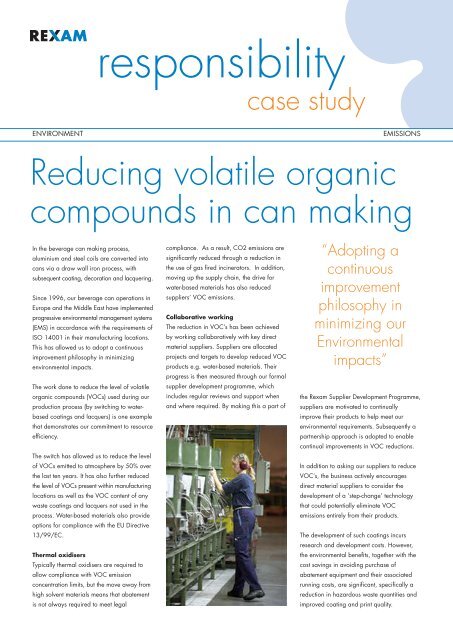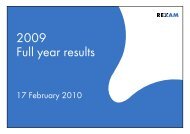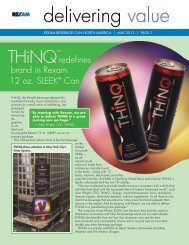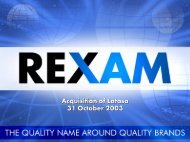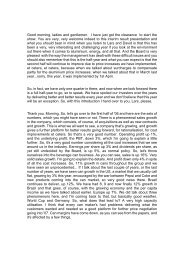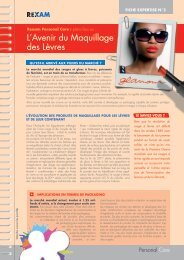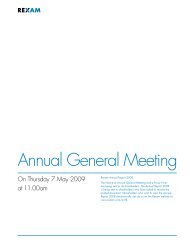All case studies
All case studies
All case studies
You also want an ePaper? Increase the reach of your titles
YUMPU automatically turns print PDFs into web optimized ePapers that Google loves.
ENVIRONMENT<br />
Reducing volatile organic<br />
compounds in can making<br />
In the beverage can making process,<br />
aluminium and steel coils are converted into<br />
cans via a draw wall iron process, with<br />
subsequent coating, decoration and lacquering.<br />
Since 1996, our beverage can operations in<br />
Europe and the Middle East have implemented<br />
progressive environmental management systems<br />
(EMS) in accordance with the requirements of<br />
ISO 14001 in their manufacturing locations.<br />
This has allowed us to adopt a continuous<br />
improvement philosophy in minimizing<br />
environmental impacts.<br />
The work done to reduce the level of volatile<br />
organic compounds (VOCs) used during our<br />
production process (by switching to water-<br />
based coatings and lacquers) is one example<br />
that demonstrates our commitment to resource<br />
efficiency.<br />
The switch has allowed us to reduce the level<br />
of VOCs emitted to atmosphere by 50% over<br />
the last ten years. It has also further reduced<br />
the level of VOCs present within manufacturing<br />
locations as well as the VOC content of any<br />
waste coatings and lacquers not used in the<br />
process. Water-based materials also provide<br />
options for compliance with the EU Directive<br />
13/99/EC.<br />
Thermal oxidisers<br />
Typically thermal oxidisers are required to<br />
allow compliance with VOC emission<br />
concentration limits, but the move away from<br />
high solvent materials means that abatement<br />
is not always required to meet legal<br />
responsibility<br />
<strong>case</strong> study<br />
compliance. As a result, CO2 emissions are<br />
significantly reduced through a reduction in<br />
the use of gas fired incinerators. In addition,<br />
moving up the supply chain, the drive for<br />
water-based materials has also reduced<br />
suppliers’ VOC emissions.<br />
Collaborative working<br />
The reduction in VOC’s has been achieved<br />
by working collaboratively with key direct<br />
material suppliers. Suppliers are allocated<br />
projects and targets to develop reduced VOC<br />
products e.g. water-based materials. Their<br />
progress is then measured through our formal<br />
supplier development programme, which<br />
includes regular reviews and support when<br />
and where required. By making this a part of<br />
the Rexam Supplier Development Programme,<br />
suppliers are motivated to continually<br />
improve their products to help meet our<br />
environmental requirements. Subsequently a<br />
partnership approach is adopted to enable<br />
continual improvements in VOC reductions.<br />
In addition to asking our suppliers to reduce<br />
VOC’s, the business actively encourages<br />
direct material suppliers to consider the<br />
development of a ‘step-change’ technology<br />
that could potentially eliminate VOC<br />
emissions entirely from their products.<br />
The development of such coatings incurs<br />
research and development costs. However,<br />
the environmental benefits, together with the<br />
cost savings in avoiding purchase of<br />
abatement equipment and their associated<br />
running costs, are significant, specifically a<br />
reduction in hazardous waste quantities and<br />
improved coating and print quality.<br />
EMISSIONS<br />
“Adopting a<br />
continuous<br />
improvement<br />
philosophy in<br />
minimizing our<br />
Environmental<br />
impacts”


